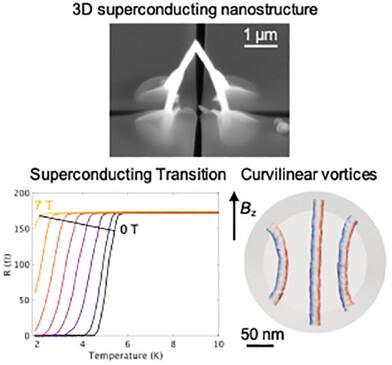可重构三维超导纳米结构
IF 19
1区 材料科学
Q1 CHEMISTRY, MULTIDISCIPLINARY
引用次数: 0
摘要
当材料在3D模式下,有机会定制和创建与复杂性增加相关的功能,打破对称性,引入曲率和非平凡拓扑。对于超导纳米结构来说,向三维空间的延伸引发了新的物理现象的出现,并导致了技术的进步。在这里,三维纳米图案被利用来制造和控制三维超导纳米结构的紧急性质。不仅在三维中证明了超导涡旋的存在和运动,而且通过数值模拟表明,约束导致了结构体积内涡旋的明确弯曲。这种三维约束在实验上表现为临界场的强几何各向异性,从而实现了三维超导结构中超导态和正常态的可重构共存,以及弱链接的局部定义。通过这种方式,揭示了纳米超导的中间状态,其中涡旋状态是真正的3D状态,可以通过几何约束来设计和操纵。这种对三维几何形状对超导特性影响的洞察,为未来的计算设备、传感器和量子技术提供了局部可重构控制的途径。本文章由计算机程序翻译,如有差异,请以英文原文为准。

Reconfigurable Three-Dimensional Superconducting Nanoarchitectures
When materials are patterned in 3D, there exist opportunities to tailor and create functionalities associated with an increase in complexity, the breaking of symmetries, and the introduction of curvature and non-trivial topologies. For superconducting nanostructures, the extension to the third dimension triggers the emergence of new physical phenomena, and lead to advances in technologies. Here, 3D nanopatterning is harnessed to fabricate and control the emergent properties of a 3D superconducting nanostructure. Not only are the existence and motion of superconducting vortices demonstrated in 3D but, with numerical simulations, it is shown that the confinement leads to well-defined bending of the vortices within the volume of the structure. This 3D confinement manifests experimentally in a strong geometrical anisotropy of the critical field, through which the reconfigurable coexistence of superconducting and normal states in the 3D superconducting architecture, and the local definition of weak links, are achieved. In this way, an intermediate regime of nanosuperconductivity is uncovered, where the vortex state is truly 3D and can be designed and manipulated by geometrical confinement. This insight into the influence of 3D geometries on superconducting properties offers a route to local reconfigurable control for future computing devices, sensors, and quantum technologies.
求助全文
通过发布文献求助,成功后即可免费获取论文全文。
去求助
来源期刊

Advanced Functional Materials
工程技术-材料科学:综合
CiteScore
29.50
自引率
4.20%
发文量
2086
审稿时长
2.1 months
期刊介绍:
Firmly established as a top-tier materials science journal, Advanced Functional Materials reports breakthrough research in all aspects of materials science, including nanotechnology, chemistry, physics, and biology every week.
Advanced Functional Materials is known for its rapid and fair peer review, quality content, and high impact, making it the first choice of the international materials science community.
 求助内容:
求助内容: 应助结果提醒方式:
应助结果提醒方式:


